DIC Department Store (Former)
DIC Building and annexe, The Drapery and General Importing Company, Harbour City Centre & Harbour City Tower, Bonaventure House/Bon Adeventure House, Entrances to office tower at 40 Panama Street and 29 Brandon Streets; 179 Lambton Quay, 181 Lambton Quay, 183 Lambton Quay, 185 Lambton Quay, 187 Lambton Quay, 189 Lambton Quay, 191 Lambton Quay

The former DIC Department Store (Image: WCC - Charles Collins, 2015)

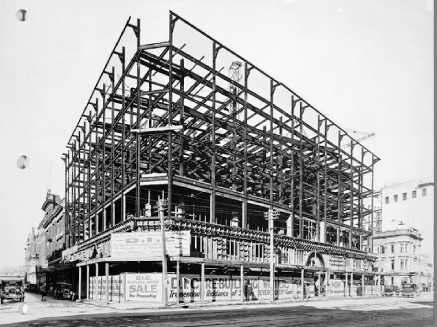
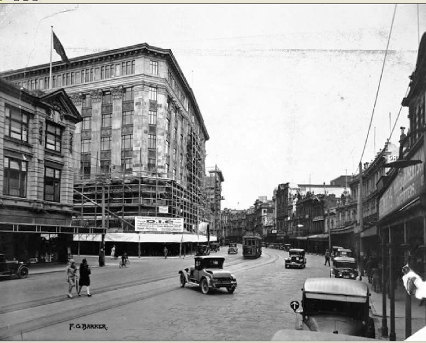
1928 - Newly constructed DIC department store, Lambton Quay between Panama Street and Brandon Street, Scaffolding has not yet been removed. Image: FG Barker WCC Archives 00138_0_11042
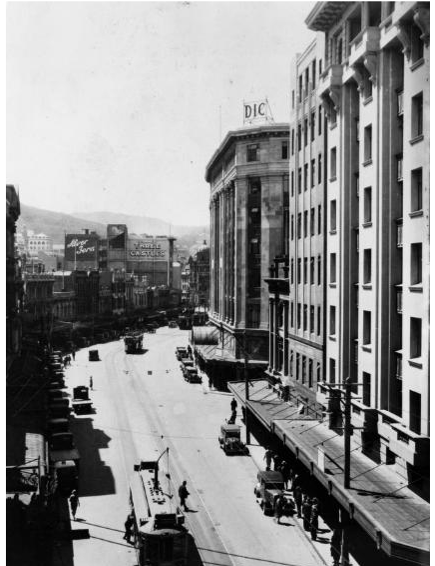
National Library reference: Lambton Quay, Wellington. Ref: 1/2-C-03564-F. Alexander Turnbull Library, Wellington, New Zealand. http://natlib.govt.nz/records/22551153
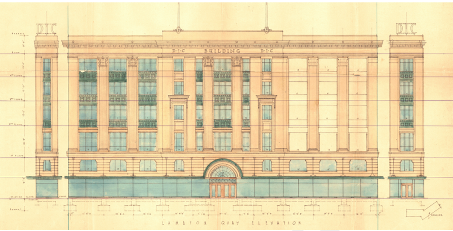
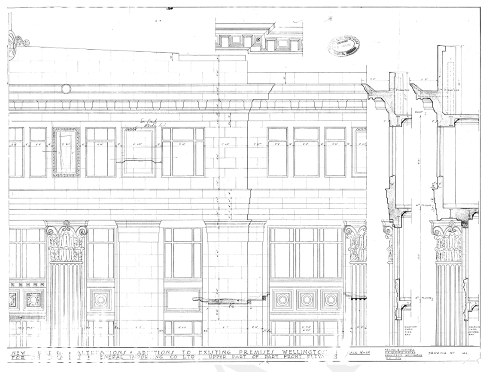
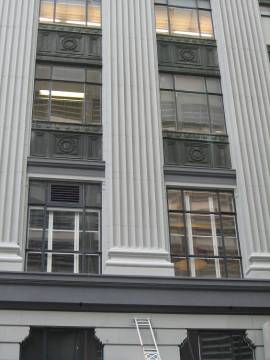
Bronze spandrel panels (Image: WCC, 2012)
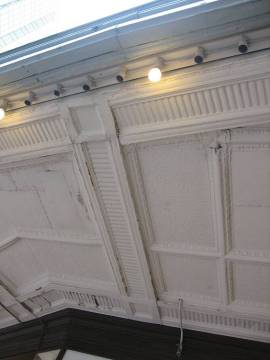
Veranda soffit (Image: WCC, 2012)
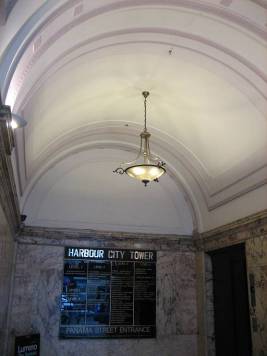
Panama Street lobby (Image: WCC, 2012)
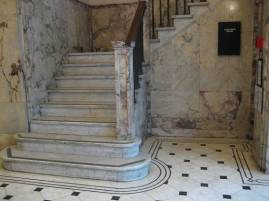
Panama Street lobby (Image: WCC, 2012)
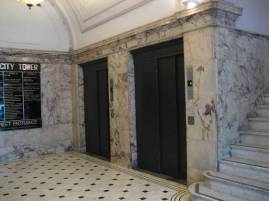
Panama Street lobby (Images: WCC, 2012)
-
Constructed
1929 - 1929
-
-
Architect(s)
-
Builder(s)
Hansford and Mills Construction Company
-
The Former DIC Department Store is an extremely fine example of the Chicago style high rise building /departmental store. It was designed by A & K Henderson, a well-known Melbourne based architecture practice.
The building is a landmark on Lambton Quay because of its size, the quality of its design and the quality of its construction materials.
The building is part of a group of high-quality buildings built in Lambton Quay in the inter-war period. These buildings include the T&G Building (also designed by A & K Henderson), the Commercial Traveller’s Club, and the façade of Hamilton Chambers.
The building is associated with DIC, a national chain of department stores founded by Bendix Hallenstein.
The building is of technical interest for its steel frame construction, the largest such steel frame at that time in New Zealand.
-
Downloadable(s)
-
close
History
-
The Drapery and General Importing Co. Ltd. was founded in 1884 by retailer Bendix Hallenstein (1835-1905), founder of the Hallenstein Brothers retailing chain. The first store opened in High Street, Dunedin.
The company thrived until the 1970s but, thereafter, poor economic times took their toll. DIC refurbished their premises from 1979 – 1981 and much of the work was designed to earthquake strengthen the then deficient 1905 original building, known as the annex. The total costs were in the region of $3,500,000, and an Evening Post article of the time noted that “DIC Ltd have helped preserve a building which is thought to be the most [architecturally] significant retail building in Wellington.”
By 1983 the company was in financial difficulties, caused in part by interest payments for the loan to cover the cost of refurbishment works and WH Smith and Brierley Investments took over the management of DIC with the aim of providing financial stability to the DIC “to enable the company to stabilise its funding base and concentrate on long term profitable departmental store trading.” The DIC building was sold to Mr David Chan, the New Zealand based son of a Hong Kong millionaire for approximately $6m (although the building was valued at $11m at the time). Chan had plans to retain the ground floor department store retail space with DIC as the major tenant but to convert the upper floors to a high class luxury hotel. The Wellington store was, however, closed in 1984 and then reopened as the Harbour City Centre, with independent retailers occupying the first two floors and offices above; the plan to develop the upper floors to a luxury hotel did not proceed. Newspaper reports of the time note that there was a public show of sentiment when DIC Wellington closed and that DIC was “…an old fashioned firm that had something almost unique these days – a family spirit reinforced by the management who, up until several years ago, could afford to be generous with the employees in small but meaningful ways.” DIC eventually folded in 1988.
1891 DIC Warehouse by James Hislop, this building was destroyed by fire in January 1905. Image: James Hislop, Bulleyment Fortune Collection.
1905 DIC building by Crichton and McKay. Image: Crighton and McKay, Bulleyment Fortune Collection.
1928 DIC department store under construction, steel structure . Image: FG Barker, WCC Archives 00138_0_11044
1928 Newly constructed DIC department store, Lambton Quay between Panama Street and Brandon Street, Scaffolding has not yet been removed. Image: FG Barker WCC Archives 00138_0_11042
Hallenstein was born in Brunswick, Germany where his family had a woollen mill. At the age of 17 he went to Manchester to learn business from his uncle, who ran a shipping business there. He followed his brothers to Victoria, Australia and there he met his future wife Mary. They married in England in 1861 and in 1863 the couple emigrated to New Zealand. Hallenstein opened his first store in Invercargill. Stores in Queenstown and other parts of Central Otago followed. He was Mayor of Queenstown and an MP but gave up public life to concentrate on a growing portfolio of businesses.
He opened his first Hallensteins in 1876 and eight years later began the DIC. A store soon opened in Christchurch but a move to Wellington was deferred until 1891 for the lack of suitable premises. That year DIC bought a building between Panama and Brandon Streets, on land leased from the Wellington City Council. A contract was let, a warehouse built and the DIC was opened for business. The store’s dual entrance was regarded as important but a Lambton Quay frontage was the main goal.
In 1905, shortly after the death of Bendix Hallenstein, the Wellington store was destroyed by fire. Temporary premises were quickly found and within nine months a new building had been erected. The company continued to try and buy up properties facing Lambton Quay.
The NZHPT Field Notes state that “in 1925 the company acquired sections 67A and 68A of the Provincial Government Reclamation from George Kersley Ltd; another drapery firm and in 1928 section 69A from the Bristol Piano Company. The balance of land fronting Lambton Quay had been leased from the Wellington City Council since 1926, allowing the company to build new premises on this frontage. This street block of land was originally created as part of the Tonks reclamation of 1866 which created Waring Taylor Street, Johnston Street, Brandon Street, Panama Street, Featherston Street, Customhouse Quay (all created circa 1877).
The flat land to the east of Lambton Quay was reclaimed in various stages from the middle of the nineteenth century onwards and the land to the west was originally a near cliff face rising to The Terrace at high level above. Lambton Quay in the mid nineteenth century was also known as The Beach or Strand and was established on the flat land above the high water mark on the Port Nicholson foreshore. Houses, shops, workshops and warehouses were built to the west of the quay, with the sea lying to the east. The first major reclamation began at Clay Point in 1857 at the intersection of Willis Street and Lambton Quay. The earthquakes of 1848 and 1855 led to the early settlers preference for timber construction, but the city’s many major fires in the later years of the nineteenth century saw the popularity of (fire resistant) brick and masonry buildings increase. The WCC Old Shoreline Heritage Trail notes that “by the 1920s, this street [Lambton Quay] had some of the city’s finest buildings in an unbroken Victorian/ Edwardian streetscape.” There are also, as noted previously, a fine collection of inter-war buildings particularly at the southern end of Lambton Quay.
The acquisition of the Lambton Quay street frontage allowed DIC to commission plans to build a large department store on the site. Designed by the Melbourne firm of Anketell and Kingsley Henderson, its construction was supervised by local firm Atkins and Mitchell. The principal contractors were Hansford and Mills and the cost of the building was £175,000. This proposal to create a department store on the Lambton Quay frontage involved demolition of approximately a quarter of the original [1905] three storey building “ … to allow for the erection of the [new] tower building.” The department store was completed in 1928 and the 1905 building helped to keep the store functioning during construction. The new building included New Zealand’s first escalator and this was a popular attraction for a building that was, for thirty years, known as one of the tallest in Wellington.
The offices were accessed via entrances to Brandon Street and Panama Street, the first three floors of offices were originally intended to be occupied by DIC staff and were served by “four of the latest high-speed lifts”. The offices have been occupied by various tenants including, apparently, the US Embassy and the South Korean Embassy.
The 1942 Wellington earthquake, which caused £10,000 worth of damage to the building, was a major setback but the company prospered after WWII. Branches were opened in many North Island centres. In 1959 women held 56.6% of the 1,225,897 total shares in the company and the company was known as a traditional one where employee long service (otherwise known as ‘a-job-for-life’) was the norm, the department store had been founded by on socialist principals and the Dunedin office was known (affectionately) as the Kremlin by some staff. The ladies’ restrooms are rumoured to have been the birthplace of one Wellingtonian “with one of the staff, Mrs McKenzie, a trained midwife, standing by to do the delivery. In the event, an ambulance man delivered the baby and Mrs McKenzie was reportedly “most miffed at missing out in taking a bizarre role in DIC’s colourful history.”
The company thrived until the 1970s but, thereafter, poor economic times took their toll. DIC refurbished their premises from 1979 – 1981 and much of the work was designed to earthquake strengthen the then deficient 1905 original building, known as the annex. The total costs were in the region of $3,500,000,[1] and an Evening Post article of the time noted that “DIC Ltd have helped preserve a building which is thought to be the most [architecturally] significant retail building in Wellington.”[2]
By 1983 the company was in financial difficulties, caused in part by interest payments for the loan to cover the cost of refurbishment works and WH Smith and Brierley Investments took over the management of DIC with the aim of providing financial stability to the DIC “to enable the company to stabilise its funding base and concentrate on long term profitable departmental store trading.”[3] The DIC building was sold to Mr David Chan, the New Zealand based son of a Hong Kong millionaire for approximately $6m (although the building was valued at $11m at the time). Chan had plans to retain the ground floor department store retail space with DIC as the major tenant but to convert the upper floors to a high class luxury hotel. The Wellington store was, however, closed in 1984 and then reopened as the Harbour City Centre, with independent retailers occupying the first two floors and offices above; the plan to develop the upper floors to a luxury hotel did not proceed. Newspaper reports of the time note that there was a public show of sentiment when DIC Wellington closed and that DIC was “…an old fashioned firm that had something almost unique these days – a family spirit reinforced by the management who, up until several years ago, could afford to be generous with the employees in small but meaningful ways.”[4] DIC eventually folded in 1988.
-
Modifications
close
-
1866 - 1867
-
Tonks reclamation of land at Panama, Brandon, Johnston and Waring Taylor, Featherston Streets and Customhouse Quay
-
1868
-
Lambton Quay fire
-
1884
-
Bendix Hallenstein founded DIC (The Drapery Importing Company Ltd) in Dunedin
-
1886
-
Lambton Quay fire
-
1891
-
DIC store opened with a frontage to Panama and Brandon Streets
-
1905
-
Fire destroyed the original DIC building and damaged the adjacent Messrs George and Kersleys Drapery. The building with Panama and Brandon Street frontages now known as the annex was then rebuilt.
-
c.1920
-
DIC obtained land with a Lambton Quay frontage
-
1929
-
The new DIC store opened with a frontage to Lambton Quay
-
1942
-
Earthquake damage to the DIC building
-
1957
-
Scaffolding accident damaged part of the verandah to Lambton Quay
-
1979 - c.1981
-
$3,500,000 refurbishment included earthquake strengthening
-
1984
-
DIC vacated the building and the ground and first floor retail space was reconfigured to form the Harbour City Centre.
-
1986
-
major refurbishment to mezzanine floor – total cost approx $1,200,000 for Bonaventure Investment Ltd, constructed by Maycroft Construction, designed by Athfield Architects
-
-
Occupation History
close
Not assessed
-
-
close
Architectural Information
-
Building Classification(s)
close
Not assessed
-
Architecture
close
The Former DIC Department Store is an extremely fine example of the Chicago style high rise building /departmental store, and at seven stories high is a prominent landmark in the retail heart of Lambton Quay. It fills the whole width of the block between Brandon Street and Panama Street, its main facade following the curve of Lambton Quay. The base is two stories high, with a verandah. There is a strong vertical emphasis to the “shaft” of the building due to close spaced, five-storey high pilasters, with the windows recessed in between, that form the dominant elements of the facades. On Lambton Quay the main entrance is framed by two massive free-standing Corinthian columns. The pilasters and columns support a strong horizontal element that caps the building. This consists of a moulded cornice, the 7th floor windows and a prominent bracketed cornice at roof level. Both street corners have a facetted profile. There have been no significant recent alterations to the exterior of this building.
Interior retail spaces have been modernised at various times, but the stairwells, corridors and some office spaces in the floors above remain little altered. Access to these spaces is by entrances on the two side streets; tiled dados and marble finishes remain in some of these spaces, and are of high aesthetic value. The building is technically interesting for its steel frame construction, the largest such steel frame at that time in New Zealand. Another technical innovation was an escalator joining the retail spaces, which is now gone.
The building shares some similarities with its near neighbour the (former) T & G Building at 203 – 213 Lambton Quay also designed by A & K Henderson, and with Burnett and Tait’s Kodak Building (1910-11) on Kingsway in London, and is built in a style and with a quality of materials that would not look out of place on the main shopping thoroughfares of many Australian, north American or English cities.
-
Materials
close
Steel framed, members set in concrete. Floors and roof of reinforced concrete.
Exterior finish ‘imitation freestone with bronze spandrel panels’
Original verandah awning ‘imitation bronze’
Marble cladding to internal walls of office lift foyers
Bronze spandrel panels (2012). Image: WCC ref 7294
Veranda soffit (2012). Image: WCC ref 7295
Panama Street lobby (2012). Images: WCC ref 7297
Panama Street lobby (2012). Images: WCC ref 7296
Panama Street lobby (2012). Images: WCC ref 7296 & 7298
-
Setting
close
Lambton Quay has developed over time to become Wellington City CBD’s “golden mile” of retail and commercial office buildings where banks, department stores and company head offices have traditionally built their highest quality buildings. This area has a high pedestrian ‘foot-count’ and is the key inner city retail shopping precinct. The street is characterised by the mix of modern office buildings and older heritage buildings, and many of the (modern) office buildings on the west side of Lambton Quay also have a street frontage or access to The Terrace commercial/office precinct. The heritage buildings make a fine contribution to a, sometimes bland, modern streetscape along Lambton Quay.
The former DIC Department Store can be read, along with the former T&G / Harcourts Building (1928), as one of a pair of A & K Henderson Buildings constructed in a similar style in the same year on Lambton Quay. This pair forms the nucleus of a fine group of inter-war (and later) buildings, often constructed as the head office of a financial institution or an insurance company at the south end of Lambton Quay. These buildings include the Art Deco styled MLC Building (1939-40), the elegant South British Insurance Building(1936) at 326 Lambton Quay, the “Chicago” Styled CBA Building (1936) at 328-330 Lambton Quay and the Art Deco styled Prudential Assurance Building(1934-35) at 332-340 Lambton Quay, along with the fine United Building(1929-30) at 107-109 on nearby Customhouse Quay.
The WCC in the mid 1970s required that all buildings meet a minimum requirement for earthquake resistant design, a consequence was that many of the older buildings in Wellington’s 'Golden Mile' were demolished and replaced with high-rise structures made of steel and glass. This development of the inner city lasted well into the 1980s.[1]
The key surviving heritage buildings in and around Lambton Quay now include: -
The Lambton Quay Cenotaph (1929)
Government Buildings (1876) at 15 Lambton Quay,
Plischke and Firth’s Massey House (1948-57) at 126 – 132 Lambton Quay,
The Edwardian Baroque Public Trust Building(1909) and Lambton Quay, the fine Gummer and Ford designed State Insurance Building (1942), both of which are located at the intersection of Stout Street and Lambton Quay
Druid’s Chambers(1924-25) 1 – 5 Woodward Street
The façade of Kirkaldie and Stains(1909, 1928 & 1988-89) at 165-177 Lambton Quay
The former DIC (1928) / Harbour City Centre at 179 – 193 Lambton Quay and the similarly styled neighbour the former T&G /Harcourts Building(1928) at 203 – 213 Lambton Quay both by A & K Henderson
Brandon House(1910) 20 Brandon Street
The Art Deco styled MLC Building (1939-40) at 231 Lambton Quay
The diminutive Kelburn Chambers (1901) at 280-284 Lambton Quay
The Lambton Quay to Upland Road Cable Car Heritage Route Area
Plimmer’s Emporium(1916) and the Lambton Quay to Boulcott Street Plimmer Steps Heritage Area
The Edwardian Whitcoulls Building at 312-316 Lambton Quay
The elegant South British Insurance Building(1936) at 326 Lambton Quay
The “Chicago” Styled CBA Building (1936) at 328-330 Lambton Quay
The Art Deco styled Prudential Assurance Building(1934-35) at 332-340 Lambton Quay
The group of older Classical styled buildings that turn the corner between 360 Lambton Quay and 2-4 Willis Street including Poy’s Building (c.1887, 1904/5), Stewart Dawson’s Building(1900) and Fletcher’s Building (1900).
The Bank of New Zealand street block of buildings at Hunter Street, and Lambton and Customhouse Quays, Building 1 (1901), Building 2 (1904), Building 3 (1885) Building 4 (1903)
The BNZ/Head Office Heritage AreaLambton Quay can also be read in the context of the various high-quality heritage buildings on nearby Customhouse Quay, Featherston Street, Hunter Street, Jervois Quay, Johnston Street and The Terrace. Lambton Quay can also be read in the context of overlapping Stout Street Heritage Area and the nearby open space of the Wellington waterfront.
-
Building Classification(s)
close
-
close
Cultural Value
The Former DIC Department Store is an extremely fine example of the Chicago style high rise building /departmental store. It was designed by A & K Henderson, a well-known Melbourne based architecture practice.
The building is a landmark on Lambton Quay because of its size, the quality of its design and the quality of its construction materials.
The building is part of a group of high-quality buildings built in Lambton Quay in the inter-war period. These buildings include the T&G Building (also designed by A & K Henderson), the Commercial Traveller’s Club, and the façade of Hamilton Chambers.
The building is associated with DIC, a national chain of department stores founded by Bendix Hallenstein.
The building is of technical interest for its steel frame construction, the largest such steel frame at that time in New Zealand.
-
Aesthetic Value
close
-
Architectural
Does the item have architectural or artistic value for characteristics that may include its design, style, era, form, scale, materials, colour, texture, patina of age, quality of space, craftsmanship, smells, and sounds?
The Former DIC Department Store is a fine example of a Chicago style high rise building /departmental store.
The building is finely crafted from high quality building materials including the bronze spandrel panels on the street facades and the two grand marble clad and ceramic tiled entrance lobbies to the office ‘tower’. -
Group
Is the item part of a group of buildings, structures, or sites that taken together have coherence because of their age, history, style, scale, materials, or use?
The building is part of a group of high-quality buildings built in Lambton Quay in the inter-war period. These buildings include the T&G Building also designed by A & K Henderson), the Commercial Traveller’s Club, and the façade of Hamilton Chambers.
-
Townscape
Does the item have townscape value for the part it plays in defining a space or street; providing visual interest; its role as a landmark; or the contribution it makes to the character and sense of place of Wellington?
The building was constructed on a grand scale, with the Lambton Quay street frontage occupying the street block between Brandon and Panama Streets and the size, quality of design, construction materials, and the building’s street presence ensures that it has remained as a local landmark.
-
-
Historic Value
close
-
Association
Is the item associated with an important person, group, or organisation?
The building is associated with DIC, a national chain of department stores founded by Bendix Hallenstein
The building was designed by A & K Henderson, a Melbourne-based practice that was at one time amongst the most successful architectural firms in Australia.
The building may be associated with the USA and South Korean Embassies (further research is required) -
Association
Is the item associated with an important historic event, theme, pattern, phase, or activity?
The building is associated with the changing corporate and physical landscape of central Wellington in the early 1980s.
-
-
Scientific Value
close
-
Archaeological
Does the item have archaeological value for its ability to provide scientific information about past human activity?
Inner city Wellington site / pre 1900 human activity on site
-
Technological
Does the item have technological value for its innovative or important construction methods or use of materials?
The building is of technical interest for its steel frame construction, the largest such steel frame at that time in New Zealand.
-
-
Social Value
close
-
Identity Sense Of Place Continuity
Is the item a focus of community, regional, or national identity? Does the item contribute to sense of place or continuity?
The building is one of the surviving pre- 1980s buildings on Lambton Quay and makes a significant contribution the sense of place and continuity to Wellington’s ‘Golden Mile’ retail and office precinct.
-
Public Esteem
Is the item held in high public esteem?
The DIC was held in high public esteem although this is now somewhat diminished. The building is highly regarded for its grand architecture.
-
Sentiment Connection
Is the item a focus of community sentiment and connection?
The DIC was the focus of community sentiment and connection although this is now somewhat diminished
-
-
Level of Cultural Heritage Significance
close
-
Authentic
Does the item have authenticity or integrity because it retains significant fabric from the time of its construction or from later periods when important additions or modifications were carried out?
The building facades and the entrance lobbies to the office tower above have had (relatively) alterations and additions and retain much of the original building fabric.
-
Rare
Is the item rare, unique, unusual, seminal, influential, or outstanding?
The building is a rare surviving example of a Chicago style high-rise building in Wellington’s ‘Golden Mile’
-
Representative
Is the item a good example of the class it represents?
The building is a good representative example of an early twentieth century ‘high-rise’ office / department building
-
-
Local / Regional / National / International Importance
close
Not assessed
-
Aesthetic Value
close
-
close
Site Detail
-
District Plan Number
17/ 183 (Lambton Quay, Brandon Street and Panama Street facades)
-
Legal Description
Lots 1, 7 & 8 DP10806 Lots 67A, 68A 70, Pt 69 Prov Govt Reclamation. HARBOUR CITY CENTRE. NOTE;THIS LAND IS PARTLY LEASEHOLD-REFER LEASEHOLD APPORTIONMENT 17260-156-A. PT RESERVE A EVANS BAY DISTRICT
-
Heritage New Zealand Listed
2/Historic place 1357
-
Archaeological Site
Central Wellington
-
Current Uses
unknown
-
Former Uses
unknown
-
Has building been funded
No
-
Funding Amount
Not applicable
-
Earthquake Prone Status
124 Notice
-
-
close
Additional Information
-
Sources
close
- WCC Heritage Building Inventory 2001 ref Lamb 6
- Te Ara biography of Bendix Hallenstein
- Julia Gatley NZHPT Field Record Forms 1989
- Fill B 1984, .C.H. Mitchell., 1891-1949, Wellington Regional Committee, NZHPT, p.19
- Mitchell and Mitchell’, NZHPT Architect’s Glossary, NZHPT, Wellington
- Alexander Turnbull Library picture collection accessed through ‘timeframes’
- WCC Archives
- Wikipedia Reclamation of Wellington Harbour accessed June 2012
- Rollo Arnold, New Zealand’s Burning — The Settlers’ World in the Mid 1880s, Victoria University Press, 1994, Wellington
- Balderstone, Susan M., 'Henderson, Kingsley Anketell (1883–1942)', Australian Dictionary of Biography, National Centre of Biography, Australian National University,
- Boffa Miskell and Chris Cochran 2001, Wellington Heritage Building Inventory, Appendix III – Wellington Architects;
- Pettigrew, Wendy and Mark Southcombe. ‘The End of the Wooden Shop: Wanganui Architecture in the 1890s’. Conference paper presented at the Centre for Building Performance Research, Victoria University, Wellington. 7th December 2007: ‘“Strident Effects of Instant Sophistication”: New Zealand Architecture in the 1890s’.
- Diana Beaglehole. ‘Wanganui: Cultural Life: Architects’. Te Ara - The Encyclopedia of New Zealand. Updated 27 November 2007.
- Stuart Gardyne, Wellington Between the Wars, VUW Thesis 1981, p 141
- NZHPT Field Record Form 1989
- WCC Old Shoreline Heritage Trail 1996 (2nd ed. 2005)
- WCC website accessed June 2012
- Newspaper articles
- ATL Subject Catalogue, DIC, q993.1, Vol.1, p.141-3;
- Evening Post, 12 May 1959; NZ Mail 18 September 1891
- Fire at the D.I.C. Wellington. Ashburton Guardian, Volume XXII, Issue 6479, 26 January 1905, Page 2;
- NZ Mail, 1 February 1905
- Wanganui Herald, 8 April 1907
- NZ Architecture and Building Review Jan 31 1928
- ‘Death of Mr Kingsley Henderson’, The Argus, 7 April 1942
- Evening Post, 24 February 1949
- Evening Post 12 May 1959
- Evening Post 19/11/1980
- The DIC Limited Annual Report 1981
- Evening Post 28/9/83
- Evening Post 4/8/83
- The DIC Sleeping Beauty Put to Rest, Wellington Cosmo July/Aug 84
- Technical Documentation close
-
Footnotes
close
Not available
-
Sources
close
Last updated: 6/20/2017 11:12:37 PM
